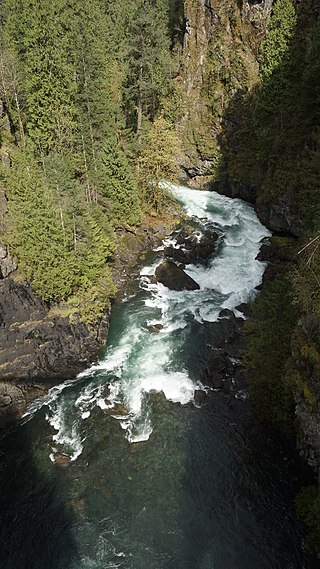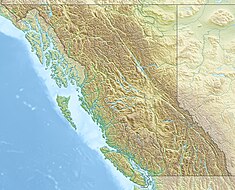The British Columbia Hydro and Power Authority, operating as BC Hydro, is a Canadian electric utility in the province of British Columbia. It is the main electricity distributor, serving more than 4 million customers in most areas, with the exception of the City of New Westminster, where the city runs its own electrical department and portions of the West Kootenay, Okanagan, the Boundary Country and Similkameen regions, where FortisBC, a subsidiary of Fortis Inc. directly provides electric service to 213,000 customers and supplies municipally owned utilities in the same area. As a provincial Crown corporation, BC Hydro reports to the BC Ministry of Energy, Mines and Low Carbon Innovation, and is regulated by the British Columbia Utilities Commission (BCUC). Its mandate is to generate, purchase, distribute and sell electricity.

Revelstoke Dam, also known as Revelstoke Canyon Dam, is a hydroelectric dam spanning the Columbia River, 5 km (3.1 mi) north of Revelstoke, British Columbia, Canada. The powerhouse was completed in 1984 and has an installed capacity of 2480 MW. Four generating units were installed initially, with one additional unit (#5) having come online in 2011. The reservoir behind the dam is named Lake Revelstoke. The dam is operated by BC Hydro.
Kakabeka Generating Station is a hydroelectric facility operated by Ontario Power Generation on the bank of the Kaministiquia River, 2 km (1.2 mi) downstream from Kakabeka Falls in the community of Kakabeka Falls, Ontario, 30 km (19 mi) west of Thunder Bay. The plant provides energy to the city of Thunder Bay and area. The station is one of ten hydroelectric stations in Ontario Power Generation's Northwest Plant Group, and is remotely operated from Thunder Bay.

The Jordan River Dam, officially the Jordan River Diversion Dam, and known locally simply as Diversion Dam, is a dam located in Jordan River, British Columbia, Canada. It is part of the second hydroelectric development on Vancouver Island.
According to the International Hydropower Association, Canada is the fourth largest producer of hydroelectricity in the world in 2021 after the United States, Brazil, and China. In 2019, Canada produced 632.2 TWh of electricity with 60% of energy coming from Hydroelectric and Tidal Energy Sources).
The Waneta Dam is a concrete gravity-type hydroelectric dam on the Pend d'Oreille River in the Canadian province of British Columbia. It lies 9.5 kilometres (6 mi) downstream of Seven Mile Dam at the Pend d'Oreille's confluence with the Columbia River. It is located about 12.5 kilometres (8 mi) southeast of Trail and 0.35 kilometres (0.2 mi) north of the U.S. border at Washington.

The Site C Dam is a hydroelectric dam currently under construction on the Peace River, 14 kilometers southwest of Fort St. John in northeastern British Columbia, Canada. It is located approximately 80 kilometers downstream from the W. A. C. Bennett Dam. When completed in 2025, the Site C Dam will become the 4th largest producer of hydroelectricity in British Columbia with an expected capacity of 1,100 MW and an expected annual output of 4,600 GWh of electricity.

The Campbell River is a river on Vancouver Island, British Columbia, Canada. It drains into Discovery Passage at the northwest end of the Strait of Georgia at the City of Campbell River. The Kwak'wala name for the river, or for the village near its mouth, at Campbell River Indian Reserve No. 11, is Tla'mataxw. The source of the river is Buttle Lake.
Veresen Inc. was a Calgary, Alberta-based energy infrastructure company with three main lines of business: pipelines, natural gas and power generation. It was a publicly-traded company on the Toronto Stock Exchange, and was known as Fort Chicago Energy Partners L.P. In 2017, it was acquired by Pembina Pipeline for $9.7 billion.
Regional Power, a subsidiary of Manulife Financial, has been developing and operating independent power projects since the mid-1980s. Currently, the firm operates six hydro plants on behalf of other developers with a total generating capacity of 36 megawatts.

The Koyna Hydroelectric Project is the second largest hydroelectric power plant in India, just after the Tehri Dam Project. It is a complex project with four dams including the largest dam on the Koyna River, Maharashtra, hence the name Koyna Hydroelectric Project. The project site is in Satara district.

Stave Falls Dam is a dual-dam power complex on the Stave River in Stave Falls, British Columbia, Canada. The dam was completed in 1912 for the primary purpose of hydroelectric power production. To increase the capacity of Stave Lake, the dam was raised in 1925 and the Blind Slough Dam constructed in an adjacent watercourse 500 m (1,600 ft) to the north, which was the site of the eponymous Stave Falls. In 2000, the dam's powerhouse was replaced after a four-year upgrade. The original Stave Falls powerhouse was once British Columbia's largest hydroelectric power source, and is a National Historic Site of Canada.

The Kootenay Canal is a hydroelectric power station, located 19 km downstream of Nelson, British Columbia, Canada. Where the Kootenay River flows out of the reservoir formed by the Corra Linn Dam on Kootenay Lake., a canal diverts water to BC Hydro's Kootenay Canal Generating Station. Its construction was a result of the Duncan Dam and Libby Dam providing year round flows into Kootenay Lake. The powerhouse was completed in 1976.
AtkinsRéalis Group Inc., previously known as SNC-Lavalin Group Inc., is a Canadian company based in Montreal that provides engineering, procurement, and construction (EPC) services to various industries, including mining and metallurgy, environment and water, infrastructure, and clean energy. AtkinsRéalis was the largest construction company, by revenue, in Canada, as of 2021.
The Kemano Generating Station is situated 75 km (47 mi) southeast of Kitimat in the province of British Columbia, Canada. It was completed in 1954, providing hydroelectricity for Alcan's Kitimat Aluminum smelter. The powerhouse is built in a cavern created 427 m (1,400 ft) inside the base of Mt Dubose. It produces 896 MW of power from its eight generator units, each of which has a capacity of 112 MW. It was the largest producer in the province when it was built, and is now the fifth largest electrical plant in British Columbia.
The Moragolla Dam is a planned hydroelectric dam in Moragolla, Sri Lanka. The dam is to be 35 m (115 ft) high and is planned to create the 1,980,000 m3 (70,000,000 cu ft) Moragolla Reservoir with a maximum supply level at 548 m (1,798 ft) MSL. Upon completion, the Moragolla Power Station would have a gross installed capacity of 30 megawatts from two francis turbines, capable of generating approximately 85 GWh annually.
Waneta Dam Expansion is a two-unit powerplant which started construction in winter of 2010/11 just downstream of the existing Waneta Dam on the Pend d'Oreille River. The dam generates power from water that would otherwise be spilled from the existing project, and is delivered to the BC Hydro grid via a separate 10 km long 230kV transmission line. The expansion project is a partnership, with Fortis Inc. holding a 51% share in the project and the two Crown agencies Columbia Power Corporation and Columbia Basin Trust holding a 32.5% and 16.5% share, respectively. SNC-Lavalin designed and built the project. In January 2019, Columbia Power and Columbia Basin Trust announced that they had agreed to purchase Fortis Inc.’s 51% interest in the facility. The purchase was concluded in April 2019.








